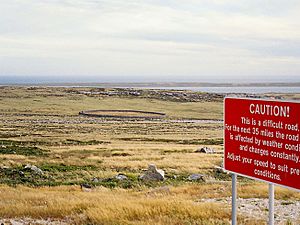East Falkland facts for kids
Quick facts for kids
East Falkland
Isla Soledad (Spanish)
|
|
|---|---|
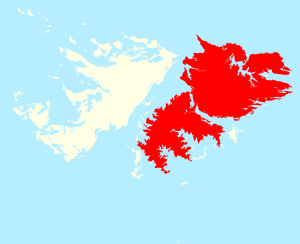
Location of East Falkland (red)
in the Falkland Islands (red & white) |
|
| Location | Atlantic Ocean |
| Archipelago | Falkland Islands |
| Area | |
| • Total | 6,605 km2 (2,550 sq mi) |
| Area rank | 1st |
| Population
(2016)
|
2,829 |
| • Rank | 1st |
| • Density | 0.42831/km2 (1.10932/sq mi) |
| Highest elevation | 705 m (2,313 ft) |
| Highest point | Mount Usborne |
| Polity | Falkland Islands |
| Largest settlement | Stanley |
| a. All islands in the Falkland Islands. b. All inhabited islands in the Falkland Islands. |
|
East Falkland (also known as Spanish: Isla Soledad) is the largest island in the Falkland Islands. It is located in the South Atlantic Ocean. This island covers about 6,605 square kilometers, which is more than half of the total area of the Falklands.
The island has two main parts. The southern part is called Lafonia. It is connected to the northern part by a narrow strip of land called an isthmus. This area was important during the Falklands War.
Most of the people in the Falkland Islands live on East Falkland. The two biggest towns, Stanley and Mount Pleasant, are both in the northern part of the island. About three-quarters of the island's population lives there.
Contents
Exploring East Falkland's Geography
East Falkland is a large island, covering about 6,605 square kilometers. It is almost split into two equal parts by two deep inlets of the sea. These are Choiseul Sound and Brenton Loch-Grantham Sound. A narrow piece of land, only 2.2 kilometers wide, connects Lafonia in the south to the northern part of the island. The island's coastline is very long, stretching for about 1,668.7 kilometers. It has many small bays and headlands.
Northern East Falkland's Landscape
The northern part of East Falkland is mostly made of old rocks like quartzite and slate. These rocks create a rugged landscape with poor, acidic soil. The main mountain range, the Wickham Heights, runs from east to west. It is about 600 meters high.
The highest point in the Falklands, Mount Usborne, is in this range. It stands at 705 meters tall. Away from the mountains, the land is mostly low and rolling. It has a mix of pasture (grassland) and marshy areas. You can also find many shallow freshwater tarns (small lakes) and small streams in the valleys. Two large inlets, Berkeley Sound and Port William, reach far into the land in the northeast. They provide safe places for ships to anchor.
Lafonia's Flatter Lands
In contrast, Lafonia in the south has younger rocks like sandstone. This makes the landscape much flatter than other parts of the island.
Other interesting natural features include Mount Simon, unique stone runs (rivers of rocks), heathland, and bogs. Gypsy Cove is a beautiful spot known for its scenery.
People and Places on East Falkland
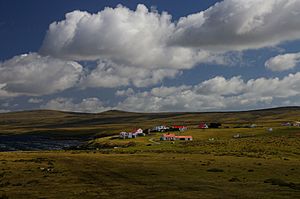

Stanley is the capital city of the Falkland Islands. It is also the main seaport and is located on East Falkland. The main Anglican cathedral of the islands, Christchurch Cathedral, is also in Stanley.
Long ago, Port Louis was the government center. But its harbor was too open to the sea. So, around 1844, a new town was planned on Stanley Harbour. This harbor was more sheltered within Port William.
Other towns and settlements on East Falkland include Port Louis, Darwin, Port San Carlos, San Carlos, Salvador, Johnson's Harbour, Fitzroy, Mare Harbour, and Goose Green.
East Falkland also has two airports with paved runways. These are Port Stanley Airport and RAF Mount Pleasant. A lighthouse stands at Cape Pembroke, near Stanley. Most of the few roads in the Falkland Islands are found on East Falkland.
East Falkland's Economy

The main ways people make a living on East Falkland are fishing, sheep farming, working for the government, and tourism. Some oats are grown, but the land is mostly used for grazing animals. This is because of the high humidity and acidic soil.
Since Stanley is the capital and East Falkland has the most people, it is the economic center of the islands. Many cruise ships now visit Stanley.
RAF Mount Pleasant, a base for British military personnel, also plays a big role in the economy. Even though there are only a few hundred military staff, their presence is very important for the island's small population.
Smaller industries include raising horses and cattle. There is also a chance that valuable minerals might be found on the island.
Wildlife of East Falkland
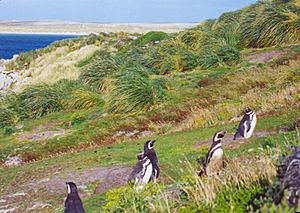
Because more people live on East Falkland, it has some challenges for nature conservation. The warrah, a type of wolf-like fox, was one of the first animals to disappear. Charles Darwin wrote about it in his book The Voyage of the Beagle:
- "The only quadruped native to the island is a large wolf-like fox... Their numbers have rapidly decreased... Within a very few years... this fox will be classed with the dodo, as an animal which has perished from the face of the earth."
Unfortunately, rats have also been brought to the island. Despite this, East Falkland has a lot of marine life, including many types of penguins.
Guanacos (animals similar to llamas) were brought to East Falkland in 1862 but did not survive. They are now extinct on the island, but can still be found on Staats Island.
Charles Darwin studied the wildlife here when he visited on the ship HMS Beagle.
History of East Falkland
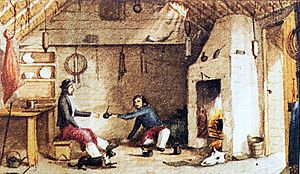
The first lasting settlement on East Falkland was started by Louis Antoine de Bougainville in 1764. He built Port Louis on Berkeley Sound. This French settlement gave the islands their name "Îles Malouines," which later became "Islas Malvinas" in Spanish. For many years, Port Louis was the main settlement on the entire archipelago.
In 1820, Colonel David Jewett claimed the islands for the United Provinces of the River Plate (which later became Argentina). Later, in 1828, Luis Vernet successfully set up a permanent settlement at Puerto Soledad. He became the first person to be called Governor of the islands.
In 1832, an American ship, the USS Lexington, visited Puerto Luis. It took back property that had been seized and declared the islands free from any ruling power. Most of the people living there decided to leave.
These events led Britain to return to the islands. On January 3, 1833, Britain asked the Argentine military presence to leave. The settlement, "Puerto Luis," was renamed "Ansons Harbour," and then "Port Louis" again. It became a British naval base and a civilian settlement.
Soon after, the ship HMS Beagle surveyed the island. Two towns on East Falkland, Darwin and Fitzroy, are named after Charles Darwin and Robert FitzRoy who were on that voyage.
In 1845, Samuel Fisher Lafone bought the southern part of East Falkland, known as Lafonia. He also bought all the wild cattle on the island. In 1851, the Falkland Islands Company bought Lafone's interest in Lafonia.
In 1859, the town of Darwin was founded. Although sheep farming began in the early 1800s, cattle farming was more common until the 1850s.
In 1925, the Bodie Suspension Bridge was built in Lafonia. It is said to be the southernmost suspension bridge in the world and is still used by people today.
The 1982 Falklands War
In April 1982, Argentina invaded East Falkland. The British Governor, Rex Hunt, was warned about the invasion. A small group of British Royal Marines and members of the Falkland Islands Defence Force (FIDF) prepared to defend the islands.
East Falkland was where most of the fighting happened during the Falklands War. Because of this, some areas of the countryside, known as the "Camp", still have many landmines. Areas with heavy fighting included Goose Green, San Carlos, Mount Longdon, and the Two Sisters ridge.
Key Battles on East Falkland
- Battle of Goose Green
- Battle of Mount Harriet
- Battle of Two Sisters
- Battle of Mount Longdon
- Battle of Mount Tumbledown
- Battle of Wireless Ridge
East Falkland Today
After the Falklands War, Britain increased its military presence on East Falkland. They also spent a lot of money improving facilities in Stanley and building more roads across the islands. The population has grown, especially in Stanley, but has decreased in the Camp (the countryside). Most of the improvements on the islands have happened on East Falkland.
Images for kids
See also
 In Spanish: Isla Soledad para niños
In Spanish: Isla Soledad para niños


